#General Pompey
Text
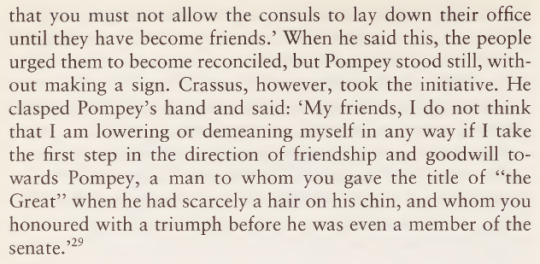
literally if I was pompey I'd like. I'd have to leave and never return to rome OR I'd have to kill him immediately
#id be MORTIFIED#there's no way to save face after that#alternatively i would simply have to marry him but its like (checks notes) give it a few generations#you'll get there#like. caesar kept faith with crassus but pompey. i cant finish that sentence actually
40 notes
·
View notes
Note
Please, what is on your Crassus playlist?
my crassus playlist is actually a crassus-sulla (maybe pompey, one of these reminds me of caesar) playlist! here it is :)
#vuja de is crassus-sulla-pompey btw#soul for sale is caesar but applicable to whomever depending on my mood#that song prompted some absolutely wild overly ambitious ideas i'm working on lmao#there's a couple of songs that aren't on that playlist like fucking. sb19's gento because it's exactly one lyric that gets my brain turning#renaissance (paulo buonvino & skin) is on my general trikaranos playlist#bc that's a villain song for me#ask tag#rec tag
21 notes
·
View notes
Text
Erich Gruen is doing a great job of making me want to yell at people who are already dead.

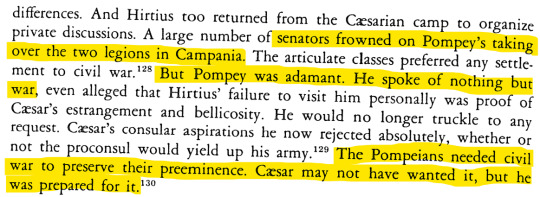
(Erich Gruen, The Last Generation of the Roman Republic, pp. 487-488)
#jlrrt reads#erich gruen#the last generation of the roman republic#pompey#caesar's civil war#julius caesar
14 notes
·
View notes
Text
ISO
I ALMOST did it. I almost took the lazy modern way and just downloaded an AI art app and told it what I wanted. But I won't do it. Making a difference and saving art means not being lazy or cheap.
So with that said I know theres a lot of art blogs I follow and who follow me and all that good stuff so if anyone thinks they would be up for the challenge of illustrating some historical figures for me I'd be very happy to see some examples of your art style and if it's what I'm looking for and come to an agreement on commissions and stuff.
Namely I need Pompeius Magnus in the style of a Lee Pace looking dude... So give me Lee Pace with gingery curls in a toga or Roman general's uniform basically
#iso art#art#anti ai#no ai art#support the artist#Pompeius Magnus#Pompey the great#Pompey#art iso#illustrations#roman art#ancient rome#how often do you think about the roman empire#the Roman empire is my Roman empire#lee pace#toga#roman generals#alexander the great
6 notes
·
View notes
Text
Everyone knows of Julius Caesar, but what about Pompey 'the Great', his rival turned ally turned rival? He almost had it all, so what went wrong?
30 notes
·
View notes
Text
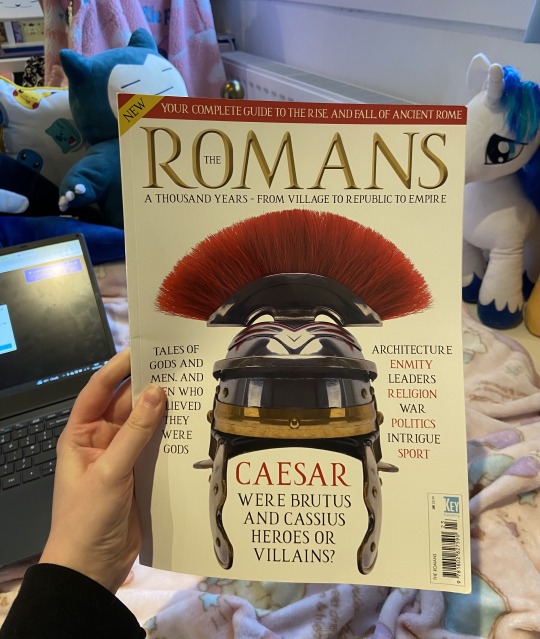
my friend bought me this i’m going to cry
#i had the worst breakdown of my life a few days ago and they wanted to get me a post breakdown gift shjkshshskk#cries and pisses. when people buy me roman stuff. or special interest stuff in general….#like you listen to me when i talk. you care about what i like#the fact that it’s a late republic one too and it’s mostly abt caesar and pompey YOU KNEW THEYRE MY FAVOURITES????
9 notes
·
View notes
Text
top ten ghosts in latin literature
#1. JULIA pharsalia book 3 my BELOVED EVIL GHOST WIFE <3#2. marcellus ig. but in propertius#3. hypothetical ghost of clodius in the pro milone#4. when every single ghost from the battle of pharsalus possesses julius caesar simultaneously in pharsalia book 7#5. hamilcar barca in the punica book 13 katabasis. hashtag hannibal has done nothing wrong in his life ever#6. tie between tityrus in eclogues 1 (dead!) and cornelius gallus like. in general#in fact maybe cornelius gallus should be higher up on the list#i cant go further w the list in fact bcs i want to put julia on it Again. the absence of julia's ghost appearing to pompey in pharsalia 7#Is Also an appearance of her ghost. except also i think she fully is there it's just not in The Narrative. only in pompey's dialogue#and everyone in the world ever has just assumed him thinking about His Wife means cornelia bcs she's like. 'alive'. no. Julia Is There#oh also aeneas is on this list. he's Dead. aeneid 10 imago rights#beeps
24 notes
·
View notes
Text




narrator voice: brutus was not.
this is playing off a few things historically: that a lot of cassius' early life before his introduction into the military/political theater under crassus during the doomed parthian campaign is non existent, which also means that this space is my sandbox to play it!
my favorite historical pairs to work with (in regards to romans, anyway) tend to fit into a gladiator/statesman dynamic, so cassius and brutus, agrippa and octavian, but also pompey and crassus fit into that mold as well (even when they're fighting with each other, the behaviors and methods they use tend to reflect the general thematic archetype)
what's really fun to sink my teeth into is how one of cassius' strengths (knowing when to step back) is also a great flaw because he consistently gave way to brutus, but brutus wasn't a good general and he's not the greatest decision maker, and letting brutus make the call frequently resulted in Worse Consequences. and somehow. brutus goes down in history as the idealized figure. what a fucking tragedy!


A Conspirator's Realism: Cassius Settles for the Second Rank, Luciano Canfora
this scene would.......probably take place around the same time brutus is having his hot girl summer being a loan shark to compliment his historical counterpart's financial adventures in salamis.
#republikang romano remixed#komiks tag#long post#EHRUGHGHHHHH okay. there we go. wahoo#this is a rough draft for now but some day i will finish it#it feels. in my heart. like a full color comic sequence. but i cant decided on blue green or green blue. for the third color#bad governance the series
295 notes
·
View notes
Text


Ancient Roman Temple Where Julius Caesar was Assassinated Opens in Rome
The square contains the remains of the Curia of Pompey, a central meeting place for senators where Caesar was stabbed to death on the Ides of March.
An ancient square where historians believe Julius Caesar was stabbed to death — one of the most infamous assassinations in history — was opened to the public for the first time Tuesday.
The Sacred Area of Largo Argentina, containing the remains of four ancient temples in a bustling part of downtown Rome, can now be seen up close via a lowered walkway for 5 euros ($5.50).
The site also contains the remains of the Curia of Pompey, a central meeting place for senators where it is believed Caesar was stabbed to death on March 15 (the Ides of March) in 44 B.C.
Successive generations had built on the site since ancient times, and it was only rediscovered when buildings were demolished in 1926. Three years later, another dictator, Mussolini, inaugurated it as an important historical site.
Two new exhibition areas also document the many archaeological finds at the site over the ages. The works were funded by the fashion house Bulgari and managed by the Capitoline Superintendency for Cultural Heritage.
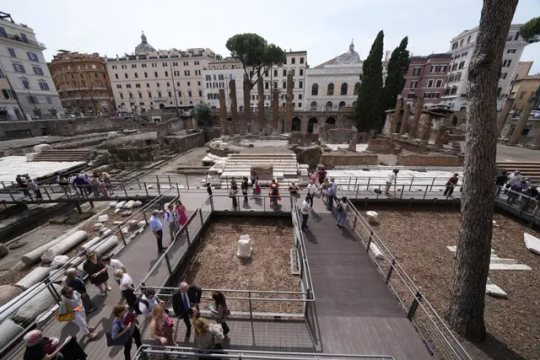
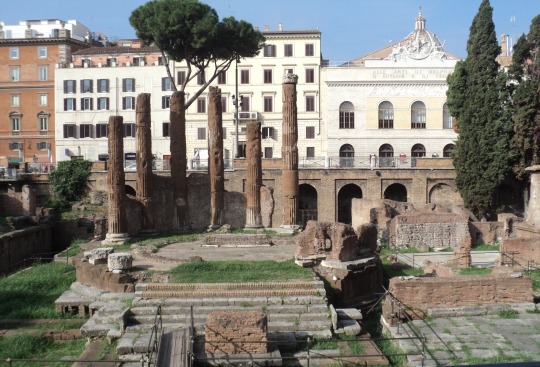

The site could previously only be seen from street level and had become overgrown with weeds. Tourists’ photos posted online show the area being enjoyed by stray cats — there is cat sanctuary on a corner of the square.
“One of the most beautiful and precious places in Rome is finally fully usable by Roman citizens and tourists, who from now on will be able to see from nearby wonderful archaeological finds from various periods of the history of our city,” Miguel Gotor, councilor for culture for the city of Rome, said in a news release.
The first recorded structure of importance on the site dates to the early third century with the construction of what is referred to as Temple C, probably dedicated to the Roman goddess Feronia.
Fires in 111 B.C. and A.D. 80 destroyed much of the earliest buildings, with those remains buried under a new floor built by the emperor Domitian in the first century.
Caesar's death has endured in Western culture as one of the most seismic political events in history, even as its details and wider implications continue to be debated.
In Shakespeare’s dramatic retelling, the dying dictator last words were “Et tu, Brute?” after he saw that his old friend Marcus Brutus, one of the murder conspiracy’s main ringleaders, was among his killers.
What is agreed upon is that Brutus and a group of Roman senators had grown concerned over the size of Caesar's power and influence and his undermining of the Republic.


However, Caesar's killing unleashed a period of reprisal and civil war that killed thousands and effectively killed the Republic. His named successor, his adopted 18-year-old son, Octavian, became what is regarded as Rome's first emperor in 27 B.C., known by then as Augustus.
Such is Italy's vast wealth of archaeological treasures that many important sites have yet to be excavated and thousands of found items have never been put on public display.
Historians' understanding of ancient Rome is still evolving as more items are found. In April a new study shed light on the use of Roman wineries in theatrical ceremonies, while in May archaeologists revealed how people were killed in an earthquake triggered by the immense eruption at Vesuvius in A.D. 79.
By Patrick Smith.
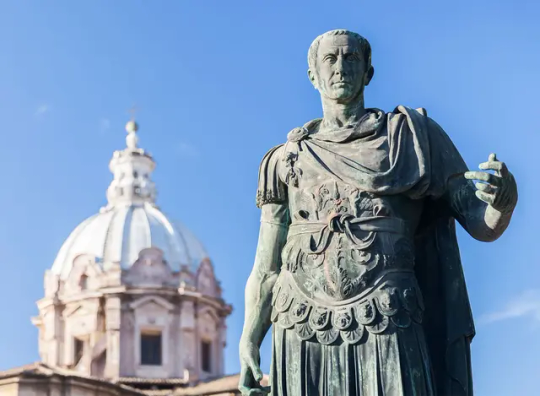



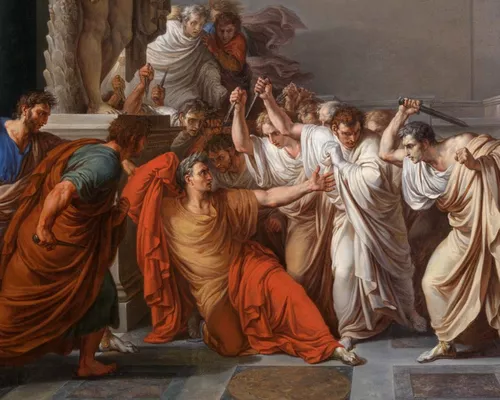
#Ancient Roman Temple Where Julius Caesar was Assassinated Opens in Rome#Curia of Pompey#The Sacred Area of Largo Argentina#Ides of March#ancient artifacts#archeology#archeolgst#history#history news#ancient history#ancient culture#ancient civilizations#ancient rome#roman history#roman empire#roman ruins#roman art
186 notes
·
View notes
Text
so sorry* to everyone who followed me back when I used to post excerpts from books I was reading on dead romans, I cleared out my reading list on a 10+ long flight and instead of finding new pdfs to read about the romans, I've decided to have fun and go through 2pm's youtube channel instead. there were three things I liked in highschool all at the same time: the italian renaissance, asian music groups, and assassin's creed. things have not changed that much.
*I'm not actually sorry, this is just very funny to me
#mostly ive been reading filipino lit and trying to figure out how to compose an email that makes sense to some historians#like hey youre THEE rizal scholar. what's up with the machiavelli mention in this thing he wrote#has anyone dissected that yet and can i read it#im also just. suffering through a biography on pompey. it'll flesh out his character i know. but ugh. at what cost#i think i need to put him down for a minute and skip forward a couple generations#to when we get an actual pompey crassus marriage going. cut out the middle man and the entire family gets executed#good grief. or octavian with his generation's crassus. biting octavian for all of that btw
3 notes
·
View notes
Text
Notes on the first triumvirate, from Gruen’s Last Generation of the Roman Republic:
First up, “triumvirate” is misleading. The Romans used that term for official government bodies of three, but the Crassus-Caesar-Pompey alliance was just an informal agreement to work together, much like the Catulus-Hortensius-Cato alliance.
Second, it didn’t dominate the government. Although Caesar, Pompey and Crassus managed to get their most critical bills passed early in 59, their popular and senatorial support started dropping, and Pompey especially lost a lot of followers. Part of this was Cato’s efforts to portray the triumvirs as tyrannical, and part of it was the aristocracy’s instinctive resistance to anyone who looked too powerful.
Gruen believes, like most historians, that the triumvirs resorted to political violence to pass legislation; Morstein-Marx believes that allegation has been overstated and taken out of context. I’ll need to compare the two authors later. What violence did occur appears to have mostly come from Pompey’s agents, and Crassus to a lesser extent, not from Caesar.
Most of the Senate were independent agents, not allied with either the triumvirs or the Catonians.
The sources of support each triumvir relied on massively shaped their fortunes during and after Caesar’s consulship:
Pompey lost more influence than he gained, since the noble families he’d allied with were quick to ditch him once he pissed them off.
Crassus remained very powerful. Most of his support came from business magnates, commoners, and junior senators who needed him in order to further their careers. Crassus didn’t need to be popular with the oligarchs. But his faction collapsed after his failed assault on Parthia and death at Carrhae.
Caesar enjoyed unprecedented success. Not only was he a skilled general, but he transformed the Gallic War into a political coalition. Caesar intentionally recruited officers from among Italians, equites, Gauls(!) and Iberians, who relied entirely on him for their political advancement, and had few connections with the Roman aristocracy. The sheer length and scale of the war created an entire generation of highly loyal soldiers, officers, and junior politicians on his side. As a result, when Caesar invaded Italy in 49, all his legions and virtually all the officers followed him. (Labienus is the only exception I know.)
(Caesar wasn’t plotting to overthrow the Roman government as he built his army. The diverse backgrounds of his officers were partly necessity, since he had so many positions to fill, and partly political, since he’d seen how unreliable Pompey’s aristocratic allies had been.)
#julius caesar#pompey#marcus licinius crassus#first triumvirate#ancient rome#erich gruen#last generation of the roman republic#jlrrt reads#jlrrt essays
7 notes
·
View notes
Text
Titus Flavius and his indelible traces.
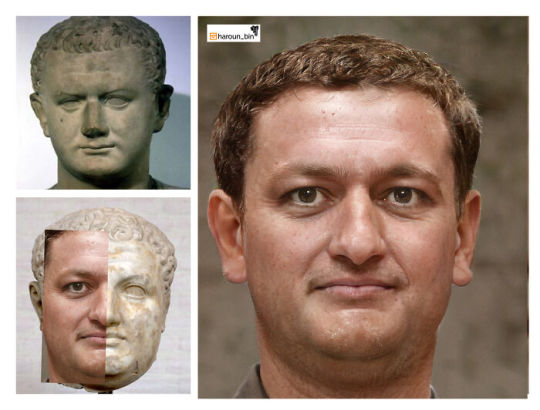

Titus Flavius was born in Rome on December 30 of the year 39. His great-grandfather had been one of Pompey Magnus's loyal soldiers during the Civil War against Julius Caesar. He escaped capture after Pompey's defeat at the Battle of Pharsalia. Years later he became a publicanus (tax collector). In an incredible twist of fate, the Flavians, a family of peasants, who came from the defeat of the past, ended up occupying the throne founded by Caesar's heir, and replacing the aristocratic Julio-Claudian dynasty with the Flavian dynasty.
During reing of Caligula (37-41) Vespasian,father of Titus, was Aedile of Rome. According Suetonius, Emperor Caligula passed by a street that was very dirty, ordered Vespasian to be brought and the garbage thrown on him, and then told him "Do your job well, keep the city clean."
During the reign of Claudius (41-54) Vespasian obtained the position of praetor and the command of one of the legions that went to the conquest of Britannia.
After revolt in Judea in the year 66, emperor Nero chose the experienced and brilliant general Vespasian to put an end to the rebellion. Vespasian went with his son, Titus, who was then 26 years old, and was an excellent army's officer.
Nero, the last of the Julio-Claudian dynasty, committed suicide in 68, which generated a civil war. On December of the chaotic year 69, known as the year of the 4 emperors, in which three aristocrats came to the throne and were murdered, Vespasian was proclaimed emperor by the army. Titus was left in command against the rebellion in Judea.
A historical event of mystical relevance.
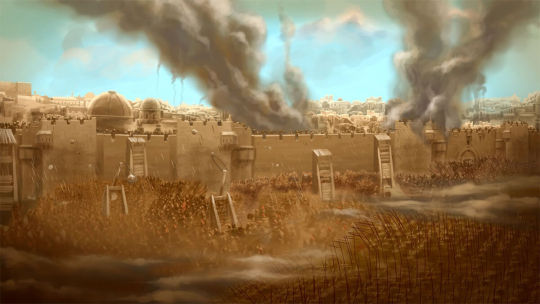
After months of bloody fighting, on August of the year 70, the Temple of Jerusalem was looted, burned and demolished by Titus's troops. This ended the rebellion in Judea.
Titus made his triumphal parade in the year 71 in Rome. Years later, in the place where Titus passed, his younger brother, the Emperor Domitian, ordered the construction of the Arch of Titus; One of its extraordinary relief depicts the triumphal parade with the treasures of the Temple.

Emperor Vespasian decided to tear down the Domus Aurea, the palace that Nero had ordered to be built for his own enjoyment, and build "a palace for the enjoyment of the people". He saw his work almost completed but died of illness on June 23, 79, at his estate. The next day Titus ascends the throne.
A mess with the gods.
Exactly 4 months after his accession to the throne and while his younger brother was celebrating his birthday, a tragic event occurred. An inexplicable and terrifying news reached Rome: the peaceful mount Vesuvius roared, exploded and became something unknown, and several Roman cities with their inhabitants disappeared under "a sea of fire." Among the victims was the prestigious politician, soldier and writer Pliny the Elder, a close friend of the imperial family, who had dedicated the book he was still writing (Naturalis historia) to Titus.

Emperor immediately went to the scene of the disaster. He made immense works and donations to help those affected in the area. Early year 80 he went there for the second time and at that time a fire broke out in Rome for three days. Rumors began to circulate that the emperor had a "problem with the gods", and it was due to his loving and forbidden relationship with the Hebrew princess Berenice.
Although he was a very popular emperor, he did not want to risk those tragedies affecting his image and the people becoming angry, so he decided in 80 to accelerate his father's work, which still had to wait to be completed. And so began the inauguration of the most famous "stadium" in history : The Flavius amphitheater, better known as The Colosseum.
There were 100 days of shows and games. Those shows were free for the people. They had never seen an amphitheater of such grandeur. Very soon the people of Rome forgot about Vesuvius and Berenice.

Coins were minted showing the work started by his father but completed and inaugurated by him. In the image: a sesterce from the time of Emperor Titus.

The pseudo-Nero.
After Nero's death, for many years rumors circulated throughout the empire, and even beyond its borders, that Nero was actually alive, hidden somewhere.
Suetonius wrote about an event that he experienced during the reign of Domitian: << Twenty years after his death, during my adolescence, a man who boasted of being Nero having appeared, found such a favorable reception among the Parthians that energetically supported, it was handed over to us with difficulty.>>
During his reign Titus had to face the rebellion of a guy called Terence Maximus, a Pseudo-Nero that according to ancient historical sources "he sang with a voice equal to that of Nero, played the lyre and looked like him." The impostor had a lot of followers in the eastern Roman provinces. The Parthian king, Titus's enemy, received this man and made preparations for him to return to Rome as emperor but he was executed when his true identity was revealed.

On September 13, 81, Titus died at the age of 41 on his father's farm, due to fever. His brief reign was very prosperous and popular.
Having only a daughter (Julia Flavia), his successor was his brother Domitian who would rule for 15 years.
The Colosseum and the Wailing Wall are undoubtedly the two indelible traces of Titus Flavius.
145 notes
·
View notes
Text
Yan!Julius Caesar Random Headcanons
❝ 📜— lady l: I love writing these random headcanons and if you guys want more historical characters feel free to send them! If you're curious about how he is yandere, I posted a general headcanon of him, which you can read by clicking here. Here are historical facts and some additional ones from my head. I hope you like it and good reading!! ❤️
❝tw: not entirely historically accurate and perhaps murder (?).

Julius Caesar was born in 100 BC and became an important Roman military and political leader. His conquest of Gaul (present-day France) and his successful campaigns contributed to his rise to power.
In 44 BC, Julius Caesar was appointed dictator for life by the Roman Senate. This move sparked concern among senators, leading to a plot that resulted in his assassination on March 15, 44 BC, known as the "Ides of March". The man did not last long as a dictator.
Julius Caesar played an important role in reforming the Roman calendar. The Julian calendar, introduced in 45 BC, was an adaptation of the lunar calendar to the solar year, forming the basis of the modern Gregorian calendar. So much so that the month of July is in his honor.
Julius Caesar formed a political alliance known as the First Triumvirate with Pompey and Crassus. They shared power and influence to advance their political and personal agendas. It didn't last long because soon they started fighting each other for power. A yandere obsessed with power, I dare say.
Julius Caesar is known for writing "Commentaries on the War in Gaul", also called as Commentarii de Bello Gallico, a series of accounts of his campaigns in the region. These writings offer valuable information about military tactics and life at that time. A great military commander and also a great fanfic writer.
There are reports that say that when he was 30 years old, he passed in front of a statue of Alexander the Great and wept because he had reached the same age and had not conquered as much as the Macedonian King. An inferiority complex, I would say.
The title "Caesar" became a dynastic name used by many Roman leaders after Julius Caesar. The first Roman Emperor, Augustus, was his nephew and adopted heir, and he adopted the title "Caesar" as part of his name. A curious fact is that many Brazilians have Caesar (César in portuguese) in their name.
In addition to his military achievements, Julius Caesar had a deep taste for literature and writing. He frequently exchanged letters and discussed poetry with various intellectuals of the day. A true cultured man and a renaissance ahead of time.
The death of Julius Caesar was one of the key events that contributed to the fall of the Roman Republic and the subsequent rise of the Roman Empire. His legacy has had a lasting impact on history and politics. Our man is credited as one of the greatest military commanders of all time.
Rumor has it that Julius Caesar had a secret superstition of avoiding black cats, believing them to bring bad luck. This contrasted with his image as a fearless leader. Poor kitty, so many powerful men were afraid of cats.
#history#yandere historical characters#yandere julius caesar#yandere julius caesar headcanons#julius caesar#headcanons#yandere headcanons#yandere history
138 notes
·
View notes
Note
Can you tell me the defining features and propogandic elements of busts from the different dynasties of Republic and Imperial Rome? That sounds super interesting and I'd love to hear about it!
Strap in.
Okay so the period that I’m going to be going over is roughly the span of time from the Republic period of Rome, all the way to Constantine, because that was the time frame my class covered.
So, to keep in mind, all of the portraits of Roman officials, whether they be emperors or otherwise, are idealized. Meaning, they are not true to life representations of these people; this is probably not how they actually looked, and you’ll see this become more prominent when we get into the imperial periods of Rome. What these portraits are in reality, are representations of traits that Romans typically admired and thought to be appropriate for rulers.
When you look at a lot of portraits from the Republic period, you’ll mainly see portraits of older people. During this time, only older people were allowed to hold powerful positions within the Roman senate, and since these were generally the people commissioning portraits of themselves, this is the bulk of what we see. It was mostly men, but some women were also depicted, which we’ll get to.

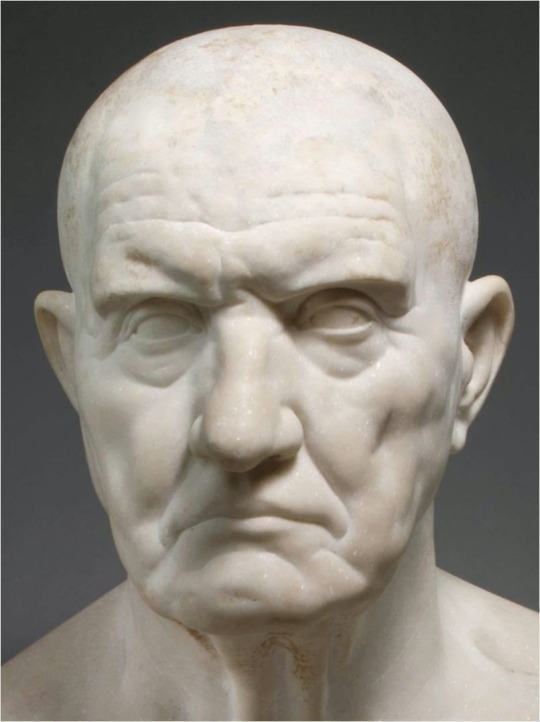
These busts portray older men, but these aren’t entirely realistic portraits, this is probably not what this individual actually looked like.
The official name for this style of portraiture is called verism, and it’s worth noting that it is pretty much a direct response to the style of the Hellenistic Greeks, who’s dynamic, emotional statues were seen as uncontrolled, with rule breaking tendencies.
These portraits are much older looking, because an older person was the physical embodiment of the kinds of traits someone from the patrician class would favor; traits such as wisdom, worldliness, piety, self-restraint. The wrinkles in the forehead and around the mouth are very pronounced and obvious. The man in this portrait might not have Actually looked like this in real life, but his real-life image did not matter; he’s trying to convey to the viewer that he is wise, and in-control of himself.
When you look at full body statues from this period, you see a strange mixing of styles, which is not uncommon, and Romans would continue to do this sort of thing in their art pieces. This is purposeful.

We see here, a man with a veristic head and an idealized body. The head is obviously meant to convey the meaning above, but the body is of a much younger man; it’s meant to convey strength and heroism. So, the entire sculpture together paints the picture of a man with the experience and constraint of an older patrician man, but the strength of a hero.
Portraits of women from this period would also be done in the veristic style, but not as intensely as their male counterparts. You can still see the agedness of this woman, and her distant expression of self-control, and dignity, but her wrinkles are not as deep and defined; she’s not meant to be as worldly as a man.

Some portraits will have individual elements mixed in with the verism. Take a look at Pompey, for instance.

He’s still keeping somewhat to the veristic style; you see from the wrinkles on his forehead and his mouth that he’s clearly meant to be seen as an older man, but his huge nose, round face and small eyes are personal traits that he really had- you see a statue from this period of time in Rome and you see that nose, there is no doubt that it’s depicting Pompey- but there’s also more to this portrait.
This is where we see some idealization start to slip back in. Take note of the hair; it’s reminiscent of Alexander the Great’s “Lion’s mane” that he’s pretty well-known for having. Pompey is choosing to depict himself with traits from Alexander, drawing a physical connection between himself and the great leader; embodying these traits and claiming them as his own, basically. He wants the viewer to associate him with Alexander the Great.
You’ll continue to see this with Caesar as well, the veristic style, but also the idealization. The idealization being him having a full head of hair, as he was reported to, uh, be balding, at least.
When we get to Augustus, he does away with verism entirely and fully embraces the classical Greek style of sculpture. He does this because he wants to connect his reign to that period of time in Greece; so right off the bat he’s making connections to legitimize himself.
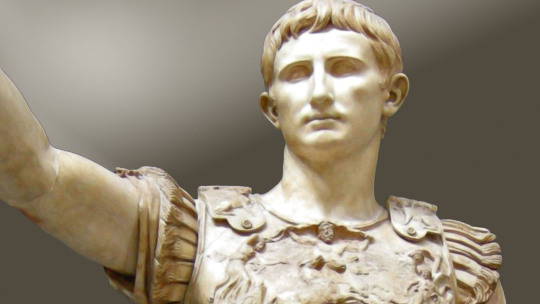
Augustus’ portraits and architectural works are rife with propaganda, so that’s an entirely different beast that we don’t have time to go into, so we’ll just stick with busts and statues.
The first thing to mention about Augustus’ portraits is that he never ages. He died in his seventies, but he became emperor young, so his portraiture kept up the appearance of him as a younger man; this is part of that classicizing style, specifically the depictions of Greek deities, whom were shown to be eternally youthful. It obviously draws inspiration from Greece, as stated, but it also meant to convey his “godly heritage” due to his descension from Caesar, who was also “descended” from Venus. You can also usually tell when a statue of Augustus was made if you look at the feet. If he’s wearing sandals, it was made while he was still living, but if he’s barefoot, then that probably means it was after he died and was defied.
His skin is smooth, he has simple, sharp features which came to be associated with the julio-claudian line. These probably are not his true features- that idealization again- but the thing that identifies his statues the most is that lock of hair that looks like a crab claw. Remember that crab-claw. It will be back later.

A lot of his full body sculptures will include these little hints and nods to his heritage, as well as his various accomplishments and inclusions of other deities. These are promises for his reign. You see Tellus a lot, she was the goddess of the Earth, and Augustus used her image a lot to convey the bounty and peace he wanted associated with his reign.
As an aside: These statues were mainly meant as stand-ins for the emperors in question, as a lot of events needed the emperor to be physically present to do, so these statues and busts would be created en-masse and placed in different places so the emperor could technically be present.
Okay, back to it.
Remember those facial features Augustus generally depicted himself with? You should, because they’re gonna keep popping up for awhile.
Throughout the rest of the Julio-Claudian dynasty, every single emperor after Augustus will keep depicting themselves with these qualities. Tiberius, who ruled right after Augustus, did this as well, despite not even being related by blood to his predecessor.


Tiberius on the right, Augustus on the left.
They’re doing what Pompey did with Alexander the Great in his portrait: depicting themselves with features associated with Augustus to draw a connection to him, essentially drawing power from his influence.
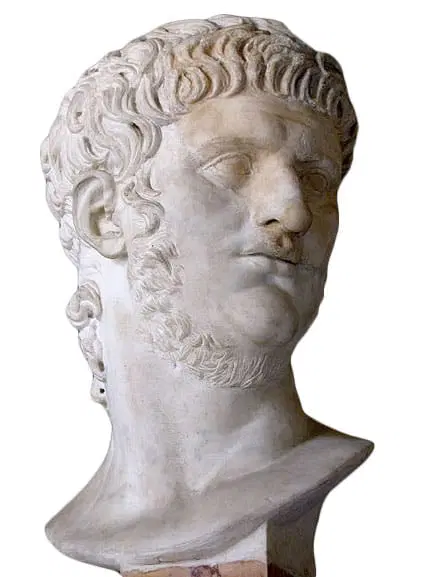

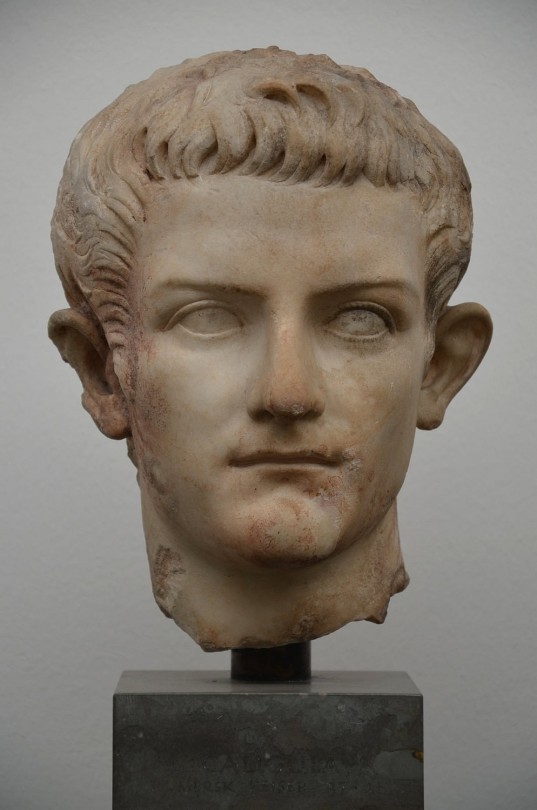
In order, Nero, Claudius, Caligula.
We see this pattern throughout the Julio-Claudian line in portraits of Caligula, Nero, Claudius as well, though Claudius is unique in the fact that, while still using those features, he also chooses to return to verism in his portraiture, partly because he was older when he ascended, but mostly due to the fact that he’s trying to shake off the immediate association with Caligula by appearing as his opposite.
We subvert a little bit when we get to that period between the Julio-Claudians and the Flavians, when there were 5 different emperors in one year (which seems like nothing when we get to the soldier-emperors later). It’s a little bit of a return to verism, to try and shake off the chaos that was Nero.

This is Vespasian, he was considered the “anti-Nero”.
You’ll probably notice by now that a lot of emperors depict themselves in certain ways also as a direct response to their predecessors, basically going like “hey, I’m not like that guy.”
With the Flavian Dynasty, we see a semi-return to verism, the men don’t look as idealized as they were, but the women would continue to appear in that more, ageless, idealized state.


Hadrian comes along later and starts depicting himself with long hair and a beard. Hadrian loved Greek culture, so the hair and beard were meant to connect him with heroes and philosophers from that time, as well as to probably hide the facial blemishes he reportedly had.
The Antonine dynasty will be dominated by this “Hadrionatic look”, as well as still having that ageless, idealized look to (most of) them. We also see some head movement in these portraits, and the introduction of new, antonine features such as droopy eyelids, and arched brows.
Rinse and repeat, the emperors that followed with this dynasty will continue to use these features to connect themselves with each other, particularly Marcus Aurelius, whom you’ll see his features repeated with Lucius Veras, and Commodus. Commodus also drew inspiration from Hercules to imbue his image with heroic qualities.
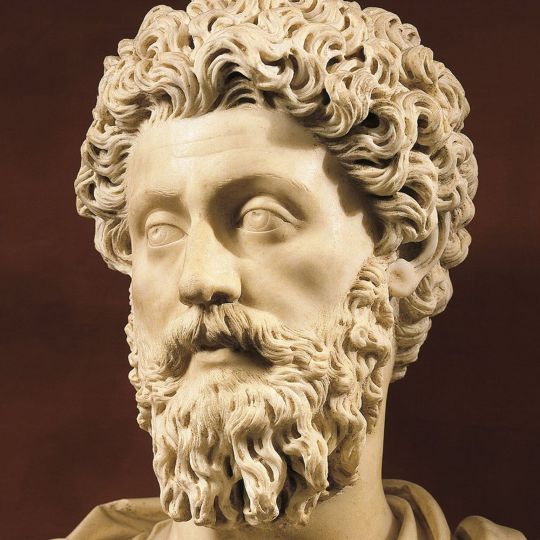
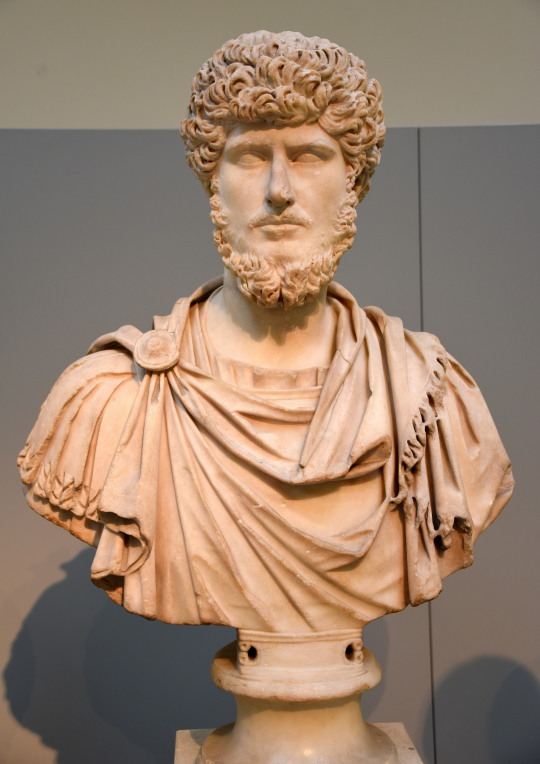

From left to right, Marcus Aurelius, Lucius Veras, Commodus
Looks nothing like the Commodus from Gladiator.
This continues up until Septimius Severus, then gets flipped on its head when Caracalla happens.
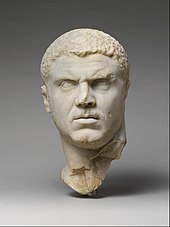
His portraits are very militaristic in style, and vastly different from what we’ve been seeing. Short cropped hair and beard; he is also very distant from the viewer. Pretty much all portraiture up until this point engaged the viewer head on, but Caracalla’s neck is dramatically turned, his eyes staring up at the ceiling. He looks very cruel and suspicious, like he does not want you there. Fitting, He did kill his own brother so he could have sole rule. This is the most personality we see in a roman portrait, ever.
This high expressionism will continue for a while with the soldier emperors: this was a period of 49 years where 25 different emperors reigned. We don’t have portraits of many of them, aside from some coins, cause most of them didn’t live long enough to get to that point.
Most of this emotionalism is fueled by the rise in neoplatonic philosophy, which placed favor on emotions rather than physical characteristics.
Also, throughout this time we’ll see quite a bit of back and forth, a lot of “I’m not that guy” because soldier emperor portraits generally had 2 modes: either the more emotional Caracalla-esque appearances, or a return to classicism to evoke the feeling of Augustus’ glory age. These were usually used in direct response to the other.
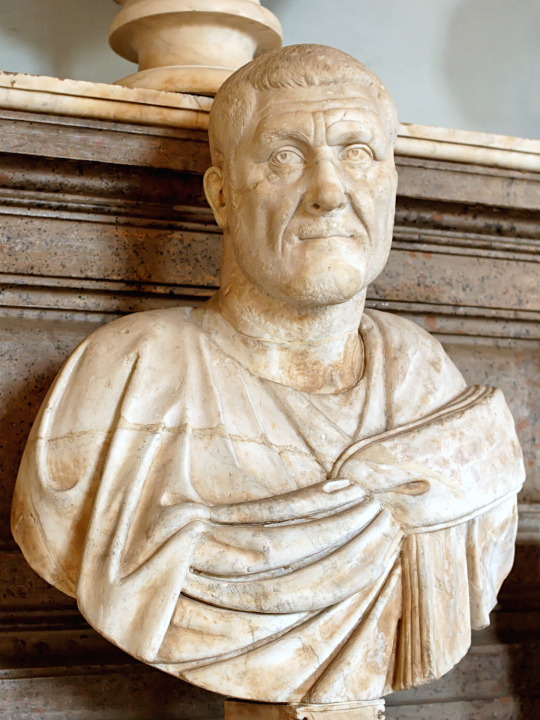
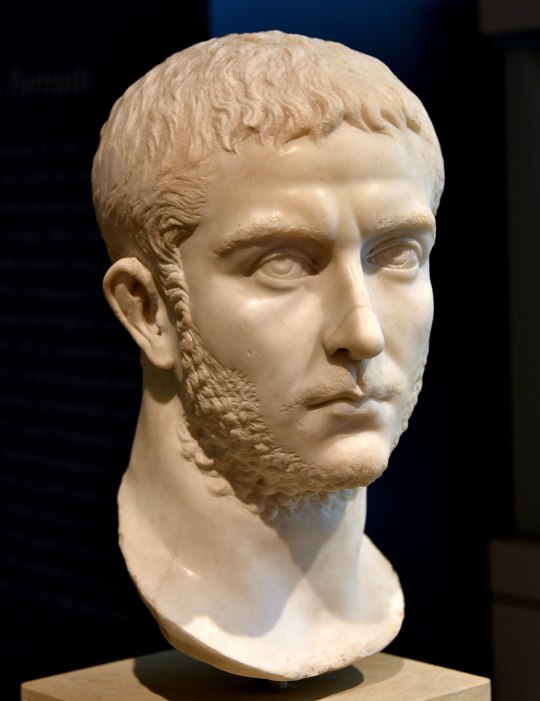
Maximinus Thrax: Mode 1 Gallienus: Mode 2
When we finally reach the Tetrarchy, we are in complete abstractism. There are no more personality defining features, and it’s virtually impossible to tell who is who. Their faces are simplified, the only difference is that some have facial hair, and some are clean shaven; and this is only to identify who is the Augustus and who is the Caesar. We still see the eyes turned away from the viewer, keeping that distance between emperor and citizen. This is purposeful, it’s meant to convey the message that the individual is not important, the position is. All the figures look the same because they’re all ruling as one unit.
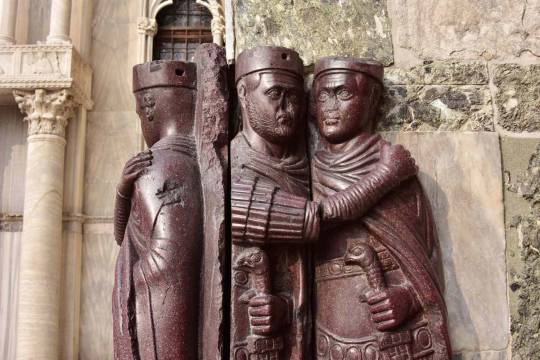
This abstraction is seen in Constantine’s portraits as well, the simplified face, the large eyes, the distant expression, but we see the hair has a little bit of detail, the comma-like look of Trajan, as well as the clean-shaven, youthful appearance of Augustus. Constantine, like so many before him, is drawing connections between himself and these past rulers, making a promise that his reign will be just as successful.
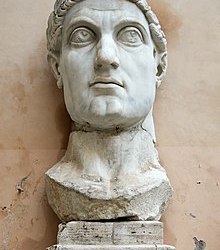
TLDR: None of these portraits reflect what these people actually looked like. They reflected values and traits that they wished to convey to the populace to instill a certain image about themselves and their subsequent reigns. They would even draw influence from past emperors and historical figures to convey the message about themselves that they wanted to convey.
#posts from the void#rome#ancient rome#I did this instead of working on the actual final paper I have to write for this class
59 notes
·
View notes
Photo

Alexander the Great: A New Life of Alexander
"Alexander the Great: A New Life of Alexander" by Paul Cartledge offers a detailed yet accessible exploration of the legendary figure's life and legacy. The author's expertise and engaging storytelling provide fresh insights into Alexander the Great's conquests and their historical significance. This book is recommended for scholars and general readers alike.
Alexander the Great's profound impact on Roman culture is undeniable, particularly when considering the fusion of Greco-Oriental influences during the Hellenistic era, which permeated Rome and, subsequently, Western Europe. His conquests paved the way for cultural diffusion and laid the groundwork for religious and imperial ideologies. His ideological legacies include figures like Pompey and Caesar. The territories Alexander the Great once controlled formed the foundation of Rome's eastern dominion, often considered the culturally and economically richer half of the empire.
However, understanding Alexander himself proves challenging due to conflicting ancient sources and continuous reinterpretations throughout history, often reflecting the agendas of interpreters.
In Alexander the Great: A New Life of Alexander, Paul Cartledge offers a captivating and comprehensive new examination of Alexander the Great. With his trademark storytelling prowess, Cartledge, chair of Cambridge University's Classics Department, guides readers through the life and conquests of Alexander with precise detail and an engaging narrative that balances discussion on Alexander's achievements with acknowledgment of places where we lack historical evidence.
Cartledge challenges prevailing notions about Alexander's motivations, particularly regarding Alexander's aim of spreading Hellenism. Cartledge argues that while Alexander was indeed attached to Hellenism, his driving force was personal glory and conquest. This nuanced perspective adds depth to our understanding of Alexander, presenting him as a complex figure driven by ambition and a thirst for success.
Central to Cartledge's exploration is Alexander's military genius. Through detailed chronicles of Alexander's battles with the Persians, Tyrians, and Babylonians, Cartledge highlights the young leader's strategic brilliance and innovative tactics. He demonstrates how Alexander's love of hunting served as a metaphor for his approach to warfare, as he adapted hunting strategies such as the surprise attack to achieve military success. This analysis sheds light on Alexander's mindset and sheds new light on his military achievements.
The book is enriched by many appendixes, including a glossary and an extensive bibliography, which enhance the reader's understanding and provide valuable resources for further exploration. Cartledge's skillful storytelling brings history to life, making the ancient world feel vivid and immediate. His vivid descriptions and storytelling make for an absorbing read that will appeal to both scholars and general readers alike.
Overall, Alexander the Great: A New Life of Alexander is a masterful biography that offers fresh insights into the life and legacy of one of history's most iconic figures. With its diligent research, engaging narrative, and nuanced analysis, this book is sure to become a definitive work on Alexander the Great for years to come. Whether the audience is a seasoned scholar or a casual reader with an interest in ancient Greece, this book is a must-read.
Continue reading...
29 notes
·
View notes
Text
Brutus joins Pompey, the murderer of his father

"Upon the general separation into two factions, when, Pompey and Caesar taking up arms against one another, the whole empire was turned into confusion, it was commonly believed that he would take Caesar's side; for his father in past time had been put to death by Pompey. But he, thinking it his duty to prefer the interest of the public to his own private feelings, and judging Pompey's to be the better cause, took part with him; though formerly he used not so much as to salute or take any notice of Pompey, if he happened to meet him, esteeming it a pollution to have the least conversation with the murderer of his father. But now, looking upon him as the general of his country, he placed himself under his command, and set sail for Cilicia in quality of lieutenant to Sestius, who had the government of that province. But finding no opportunity there of doing any great service, and hearing that Pompey and Caesar were now near one another and preparing for the battle upon which all depended, he came of his own accord to Macedonia to partake in the danger. At his coming it is said that Pompey was so surprised and so pleased that, rising from his chair in the sight of all who were about him, he saluted and embraced him, as one of the chiefest of his party." ~Plutarch's Life of Brutus
#brutus#marcus brutus#marcus junius brutus#ancient rome#the conspirators#roman republic#roman history#roman empire#rome#gaius julius caesar#julius caesar#pompey#gnaeus pompeius magnus#plutarch#quotes#ides of march
69 notes
·
View notes